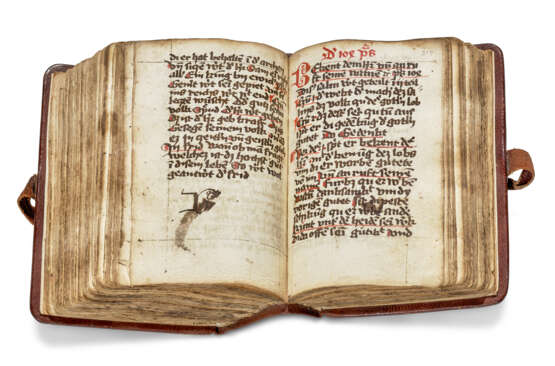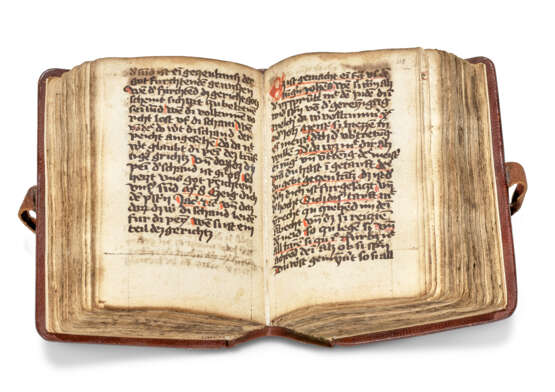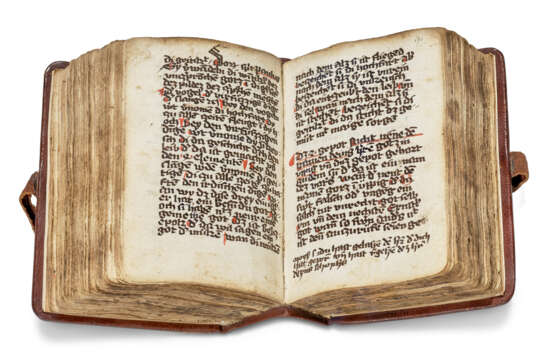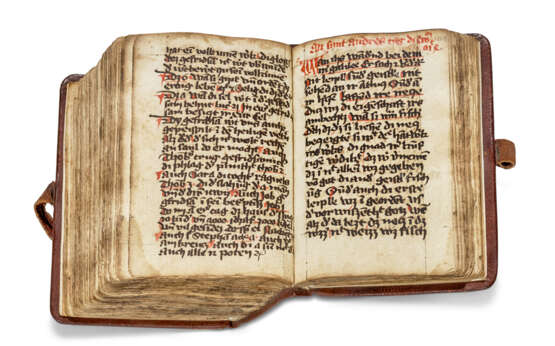ID 1249868
Lot 34 | A manuscript of German sermons
Estimate value
£ 4 000 – 6 000
Sermons, in German, decorated manuscript on paper [Southern Germany, last third 15th century]
A pocket-sized manuscript of German sermons.
109 x 72, iii + 292 + i vellum (former pastedown) + iii: 12(from original first gathering of ?12), 211(of 12 lacking i), 3-412, 59(?of 10 lacking x), 6-812, 910, 10-1112, 125(uncertain), 1313(of 14 lacking ii), 1412, 1511(of 12 lacking xii), 1611(of 12, ?xii cancelled blank), 1712, 18-19 uncertain: perhaps 188(of 12, lacking i-ii, xi-xii attached to 19), 1913(of 12, stitched ff.196-197, xii cancelled blank, first two leaves from 18, 2012, 2110(of 12, ?xi-xii cancelled blanks), 2212, 2316(of 18, lacking ii and xvii), 24-2612, 275(of 6, ?vi cancelled blank), some catchwords, signatures 4-17 and 20-24 at lower left of first recto, mostly 19-21 lines, written above top line of ruled space: 78 x 50mm, except for gathering 24, ff.252-263: 84 x 50mm, with no internal lines, one four-line initial in red flourished in black and red, two- to three-line initials, some simply flourished, headings, paraphs and underlinings in red, one- to two-line initials touched with red (lacking most of first gathering and further leaves, lower part of ff.168 and 192 torn out, cut into text ff.132-133, small tear into text on verso f.142, smudging to top lines on some folios). Brown leather binding by Otto Schoultz (1858-1921) of Göteborg (Gothenburg, Sweden) with leather ties, rebound with guards (lower tie broken, light wear to extremities).
Provenance:
The text indicates an origin in southern Germany and the Arabic numerals a date in the later part of the 15th century. Sermons in the vernacular, primarily for the laity, could have been delivered by a member of a religious order as well as by a parish priest. St Andrew may have been the local patron - of the church or religious house - since, of the three sermons for saint’s days, one is for the St Andrew’s procession. The former pastedown comes from a 14th-century liturgical book.
Various scribbles on blank leaves, including: ?counting boards on f.92v; Sum ex libris on f.201v is followed by the Latin tag palma palpamus and a partly overwritten record of buying an ell of linen in a different hand, 18th-19th century, Item eine [cancelled] elle [...]. Leinwand gekaufft 8 gl [gulden], the currency implying that the book was still in southern Germany.
It appears to have reached Sweden with a similarly sized Prayerbook in cursive hands on paper (104 x 73mm) in a matching binding by Otto Schoultz (Stockholms Auktionsverk, 7 December 2023, lot 323). The more formal script of the Sermons may reflect their significance or the need for easier legibility. The Prayerbook preserved a shelfmark and traces of a German sale catalogue of c.1900. The early 19th-century secularisation of monasteries and other church properties may have released both books onto the market.
Content:
Sermons or notes for sermons, mostly on the New Testament, opening: Waz hastu uf dem daz da ist […] perhaps on Matthew 12 on false Christs and prophets, f.1, and including: on the Beatitudes (Matthew 5 ii-xi) ff.26-46v; on the calling of the Apostles (John 1) ff.54v-60v; the Marriage at Cana and Cleansing of the Temple (John 2) ff.61-70v; on the Sermon on the Mount (Matthew 5 xv-end) ff.71-92; on the guiding angel (Exodus 23 xx) ff.113-117v; on St George’s Day (23 April), ff.188-193; Sts Philip and James (3 May) ff.200v-201; on various psalms ff.202-235; for the second Thursday in Lent, Am 2 pfinztag in den vasten f.252; for St Andrew’s Procession, An sant Andres tzug ff.264-269v; some contemporary annotations and corrections throughout.
German vernacular Bibles were widely available in manuscript before becoming a popular enterprise for printers. The source of the quotations used in the sermons has yet to be identified: it could help to localise the collection’s origin.
| Place of origin: | Western Europe, Germany, Europe |
|---|---|
| Auction house category: | Medieval & renaissance manuscripts, Books and manuscripts |
| Place of origin: | Western Europe, Germany, Europe |
|---|---|
| Auction house category: | Medieval & renaissance manuscripts, Books and manuscripts |
| Address of auction |
CHRISTIE'S 8 King Street, St. James's SW1Y 6QT London United Kingdom | |
|---|---|---|
| Preview |
| |
| Phone | +44 (0)20 7839 9060 | |
| Buyer Premium | see on Website | |
| Conditions of purchase | Conditions of purchase |






